Introduction:
Social media marketing and advertising have become an integral part of the marketing mix for businesses of all sizes. Over the years, social media platforms have evolved to become powerful marketing tools, providing businesses with a unique opportunity to reach and engage with their target audience in a more personalized and effective way. In this article, we will explore the evolution of social media marketing and advertising, and the impact it has had on the marketing landscape.
Emergence of Social Media Platforms:
The first wave of social media platforms, such as Friendster and MySpace, emerged in the early 2000s. These platforms allowed users to create profiles, connect with friends, and share content, but they were not initially designed for marketing purposes.
However, the emergence of Facebook in 2004 marked a turning point for social media marketing. With its massive user base and sophisticated targeting capabilities, Facebook quickly became a popular platform for businesses to reach their target audience.
Introduction of Paid Advertising:
In 2005, Facebook introduced its first advertising offering, which allowed businesses to create and display ads to targeted audiences based on demographics, interests, and behaviors. This marked a significant shift in the way businesses approached social media marketing, as it allowed them to reach a much larger audience than organic posts alone.
Other social media platforms, such as Twitter and LinkedIn, soon followed suit and introduced their own advertising offerings.
Rise of Influencer Marketing:
Influencer marketing is a form of social media marketing that involves partnering with individuals who have a large following on social media to promote a brand or product. This form of marketing has become increasingly popular in recent years, with businesses of all sizes partnering with influencers to reach their target audience.
Influencer marketing provides businesses with a more authentic and personal way to connect with their target audience, as influencers have already established a relationship of trust with their followers.
Growth of Video Content:
The rise of video content has been another major trend in social media marketing. Platforms such as YouTube, Instagram, and TikTok have become popular destinations for video content, with businesses using these platforms to share product demos, behind-the-scenes content, and other types of engaging video content.
The growth of video content has also led to the rise of livestreaming, which has become a popular way for businesses to connect with their audience in real-time.
Evolution of Targeting Capabilities:
The targeting capabilities of social media platforms have become increasingly sophisticated over the years, allowing businesses to reach their target audience with greater precision. Platforms such as Facebook and Instagram now offer a wide range of targeting options, including demographic, geographic, and interest-based targeting.
In addition, platforms have introduced new targeting capabilities, such as lookalike targeting, which allows businesses to target users who are similar to their existing customers, and retargeting, which allows businesses to show ads to users who have previously interacted with their brand.
Integration with E-commerce:
Social media platforms have also become increasingly integrated with e-commerce, allowing businesses to sell products directly through social media channels. Platforms such as Instagram and Facebook now offer in-app checkout, allowing users to purchase products without leaving the app.
This integration has made it easier for businesses to convert social media followers into customers and has opened up new revenue streams for social media platforms.
Conclusion:
The evolution of social media marketing and advertising has transformed the way businesses approach marketing. Social media platforms have become powerful marketing tools, providing businesses with a unique opportunity to reach and engage with their target audience in a more personalized and effective way. The continued growth of social media and the ongoing development of new features and capabilities will undoubtedly continue to shape the marketing landscape in the years to come.




0 Comments